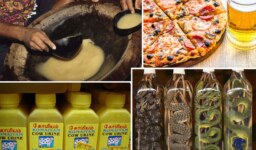Beaches are magical places that can offer fun and relaxation. Almost everyone loves the beach fun, especially the little ones. Building sandcastles, burying someone in the sand, and collecting seashells are the most common activities to have fun at a beach. And for those who like to stay calm rather than playing at a beach the sunset can present you with a fascinating view. But today we are not going to talk about beach fun. We have explored an extraordinary beach in China which is truly wondrous.
China has secured the title of “the most visited destination” due to its astonishing sights. The Great Wall of China, The Forbidden City & the Imperial Palace, Beijing, The Terracotta Army, Xi’an, The Summer Palace, Beijing, and Cruising the Li River, Guilin are some of the places that tourists who visit china never forget to visit. But today we are going to navigate our article through the exclusive view of the Red Beach in China.
The Red Beach in China has something exotic. As intended in the name, this beach is in the color of crimson red. This beach has located in Panjin. Situated in China’s Liaoning province. It is approximately a six-hour drive from Beijing. It is also known as “The red carpet beach” because of the stunning view which reminds a massive crimson color carpet.

The Red beach, China in different seasons
World’s Largest wetland
The quintessential fact about the red beach is that it is the largest wetland in the world. It has spread over 132 square kilometers. The Liaohe River nourishes the whole wetland. Moreover, the unusual solution of the Liaohe water has initiated the unique features of the area. The whole area looks like a part fell over from mars. There is crimson everywhere. The stunning view of the area can mesmerize tourists all over the world. The harmony of tributaries of the Liaohe river, deltas, and crimson land draw a picture of human veins.
Biodiversity in the area
The credit for this wetland’s gorgeous crimson color goes to a seaweed called ?????? ?????. ?????? ????? is considered to be a halophile plant. Halophile plants are crops that can grow in saline environments. Moreover, Halophile plants grow in waters that have salt concentrations 5 times higher than seawater. ?????? ????? is not red when it starts growing. Also the red beach is not red every period of the year.
This plant is green when starting to sprout in April. Liaohe River’s sediments precipitate the growth of ?????? ?????. These grass absorb chemical particles and minerals from the river. This alkaline tolerance turns the seaweed into crimson color. This wetland glimmers in crimson color in the Autumn that spreads from August to October. That is the best time of the year to pay a visit to this enchanting landscape. Finally, this crop turns purple when the winter is in the corner.
This special feature of surviving in harsh environments have gotten this crop a special place in bio diesel production. Most of he research papers about bio diesel are based on this crop.

The Red beach, China board walk
The Biodiversity in the Area
Most of the zones which have alkaline water have less biodiversity but the Red beach consists of a rich variety of biodiversity. This area is the habit of the most endangered crane “the Red Crown Crane”. Furthermore, there are more than 260 bird species and 399 other animals who are habituating here. Also, white cranes, oriental white storks, wild geese, and ducks stop in this area while migrating. Birds such as white swan, egrets, heron, garganey, and swan goose habituate in the area.
Why does Liaohe have alkaline water?
Many resources claim that the river contains salty water because of the pollution. The third-largest crude oil deposit in China is located near the red beach. Due to this fact, there are strict requirements for conserving this area. The Authorities of China have taken many actions in order to fulfill the Red beach preserving process. For instance, they built a 2000m long boardwalk for the visitors in order to protect the natural balance of the area.
The surrounding lands in Red beach have been consumed for growing short-grained rice and bamboo shoots. Furthermore, they grow reeds and produce paper for the market.
So, what do you think about this amazing creation of mother nature? Have you got the chance to visit here? Leave a comment down below.




